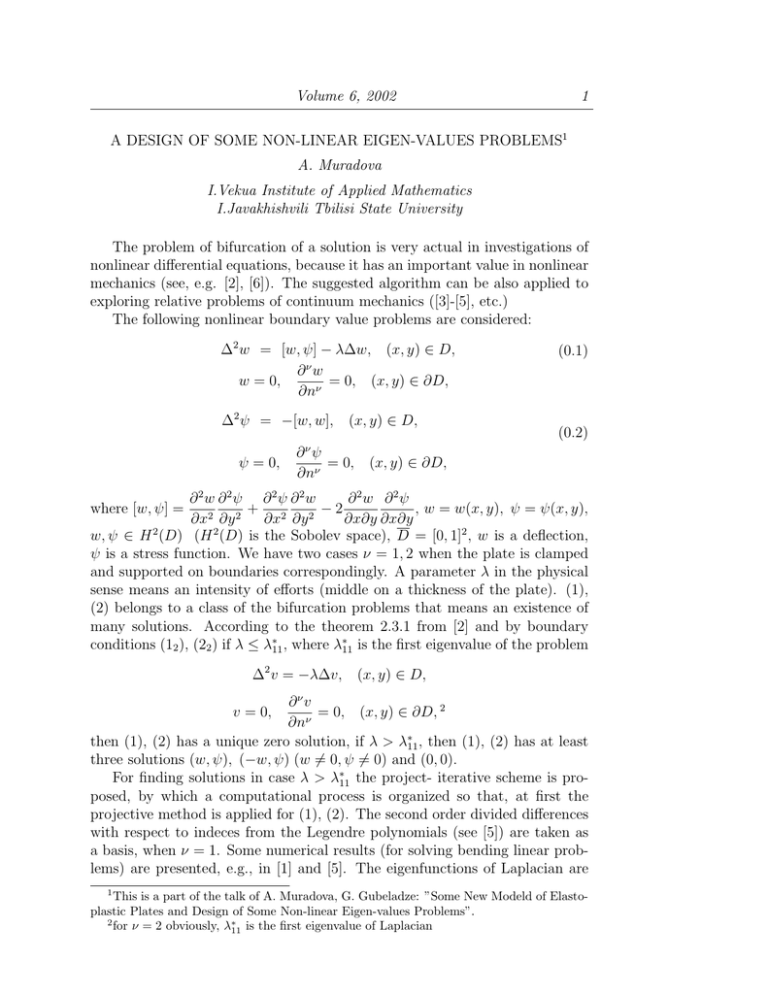Volume 6, 2002 1 A. Muradova I.Vekua Institute of Applied Mathematics
advertisement

Volume 6, 2002 1 A DESIGN OF SOME NON-LINEAR EIGEN-VALUES PROBLEMS1 A. Muradova I.Vekua Institute of Applied Mathematics I.Javakhishvili Tbilisi State University The problem of bifurcation of a solution is very actual in investigations of nonlinear differential equations, because it has an important value in nonlinear mechanics (see, e.g. [2], [6]). The suggested algorithm can be also applied to exploring relative problems of continuum mechanics ([3]-[5], etc.) The following nonlinear boundary value problems are considered: ∆2 w = [w, ψ] − λ∆w, (x, y) ∈ D, ∂ν w w = 0, = 0, (x, y) ∈ ∂D, ∂nν ∆2 ψ = −[w, w], (x, y) ∈ D, (0.1) (0.2) ν ψ = 0, ∂ ψ = 0, (x, y) ∈ ∂D, ∂nν ∂ 2w ∂2ψ ∂2w ∂ 2ψ ∂ 2ψ ∂2w + − 2 , w = w(x, y), ψ = ψ(x, y), ∂x2 ∂y 2 ∂x2 ∂y 2 ∂x∂y ∂x∂y w, ψ ∈ H 2 (D) (H 2 (D) is the Sobolev space), D = [0, 1]2 , w is a deflection, ψ is a stress function. We have two cases ν = 1, 2 when the plate is clamped and supported on boundaries correspondingly. A parameter λ in the physical sense means an intensity of efforts (middle on a thickness of the plate). (1), (2) belongs to a class of the bifurcation problems that means an existence of many solutions. According to the theorem 2.3.1 from [2] and by boundary conditions (12 ), (22 ) if λ ≤ λ∗11 , where λ∗11 is the first eigenvalue of the problem where [w, ψ] = ∆2 v = −λ∆v, (x, y) ∈ D, ∂ν v = 0, (x, y) ∈ ∂D, 2 ∂nν then (1), (2) has a unique zero solution, if λ > λ∗11 , then (1), (2) has at least 6 0) and (0, 0). three solutions (w, ψ), (−w, ψ) (w = 6 0, ψ = For finding solutions in case λ > λ∗11 the project- iterative scheme is proposed, by which a computational process is organized so that, at first the projective method is applied for (1), (2). The second order divided differences with respect to indeces from the Legendre polynomials (see [5]) are taken as a basis, when ν = 1. Some numerical results (for solving bending linear problems) are presented, e.g., in [1] and [5]. The eigenfunctions of Laplacian are v = 0, 1 This is a part of the talk of A. Muradova, G. Gubeladze: ”Some New Modeld of Elastoplastic Plates and Design of Some Non-linear Eigen-values Problems”. ∗ 2 is the first eigenvalue of Laplacian for ν = 2 obviously, λ11 2 Bulletin of TICMI taken as a basis, when ν = 2. Further, after getting the system of nonlinear algebraic equations by an iterative method on the basis of the incremental loading, Runge-Kutta and Newton methods (see, e.g., [4]) a search of eigenfunctions in the bifurcation points is realized. We find the solution of (1), (2) as WN (x, y) = N X ij wN ωij (x, y), ΨN (x, y) = i,j=1 N X ij ψN ωij (x, y), (0.3) i,j=1 where, when ν = 1 : ωij (x, y) = χ2 Pi (x)χ2 Pj (y) and when ν = 2 : ωij (x, y) = 2 sin πix sin πjy. The system of functions ωij is a complete orthonormal system and satisfies the boundary conditions (11 ), (22 ). The use of the eigenfunctions of Laplacian as a special basis for getting apriori estimations is presented in details [3]. By Galerkin method for (1), (2) we have a system of nonlinear algebraic ij ij equations with respect to wN , ψN : AN wN = BN (wN , ψN ) + λCN wN , (0.4) AN ψN = −BN (wN , wN ), (0.5) m, n = 1, 2, . . . , N. Here BN is a nonlinear quadratic operator; AN , CN are linear operators, for ν = 1 presented in [5] and for another case AN = I, CN is a diagonal matrix with elements CNmn = π −2 (m2 + n2 )−1 . After getting the nonlinear algebraic mn system of equations with respect to wN we consider the iterative scheme, using the incremental loading, Runge-Kutta and Newton methods for ν = 2 and only Newton method for ν = 1. Naturally, an inversion of the corresponding Jacobian in Newton method presents certain difficulties, which is connected with a limited volume of computer memory for storing matrices, and also a volume of computations for inversing Jacobian itself. To escape these difficulties we can use hybrid iterative methods, for example, the nonlinear Seidel method with the method of incremental loading and the Newton method with Seidel method together. In addition, for ν = 1 as so we can not compute the derivatives we will apply the corresponding central difference derivatives of the second order of exactness. r,γr Fot calculating ψN we use the formula (5) r,γr r,γr r,γr ψN = −A−1 N BN (wN , wN ), m, n = 1, 2, . . . , N. The iterative process is carried out so that at first solutions for λ = λ0 = 0,0 λ∗11 + ε (r = 0) are considered. For this purpose initial approximations wN are chosen. For some exactness a certain number of iterations are realized and 0,γ0 0,γ0 computed wN by the Newton method. Further, the obtained values wN are 0,γ0 used for calculating ψN . Thus, we obtain eigenfunctions for λ = λ0 . Then by Volume 6, 2002 1 1 3 1,0 the incremental loading method we find wN (wN = wN ) as an initial approxi1,γ1 mation for computing wN by the Newton method for λ1 = λ0 + h, h > 0 with 0,γ0 0,γ0 0 account of wN = wN . It is also possible to use wN as an initial approximation 1,γ1 for computing wN without applying the incremental loading method that we use for ν = 1. Continuing these procedures by so that we obtain eigenfunctions r,γr r,γr wN , ψN , r = 0, 1, . . . , M. Obviously, according to this aproach we can sort out solutions and find the bifurcation points. REFERENCES [1] Chkhaidze Kh., Muradova A., Vashakmadze T. To Design of Some Bending Problems. Reports of Enlarged Sessions of the Seminar of VIAM, v. 13, No.4, 1998, pp. 24-27 [2] Ciarlet P., Rabier P. Les Equations de von Karman. Springer-Verlag, Berlin, Heidelberg, New York, 1980 [3] Lions J.L. Quelques Méthodes de Résolution des Problèmes aux Limites non Linéaires. Dunod Gauthier-villars, Paris, 1969 [4] Oden J.T. Finite Elements of Nonlinear Continua, McGRAW-HILL BOOK COMPANY, New York, 1972 [5] Vashakmadze Tamaz S. The Theory of Anizotropic Elastic Plates. Kluwer Academic Publishes, Dortrecht/Boston/London, 1999 [6] Weinberg M. M., Trenogin V. A. The Bifurcation Theory of Nonlinear Equations, ”Nauka”, Moskow, 1969 (Russian) Acknowledgment: The author is grateful to Professor T. Vashakmadze for some useful suggestions and interest in the paper. Received October 10, 2002; revised November 20, 2002; accepted December 7, 2002.








